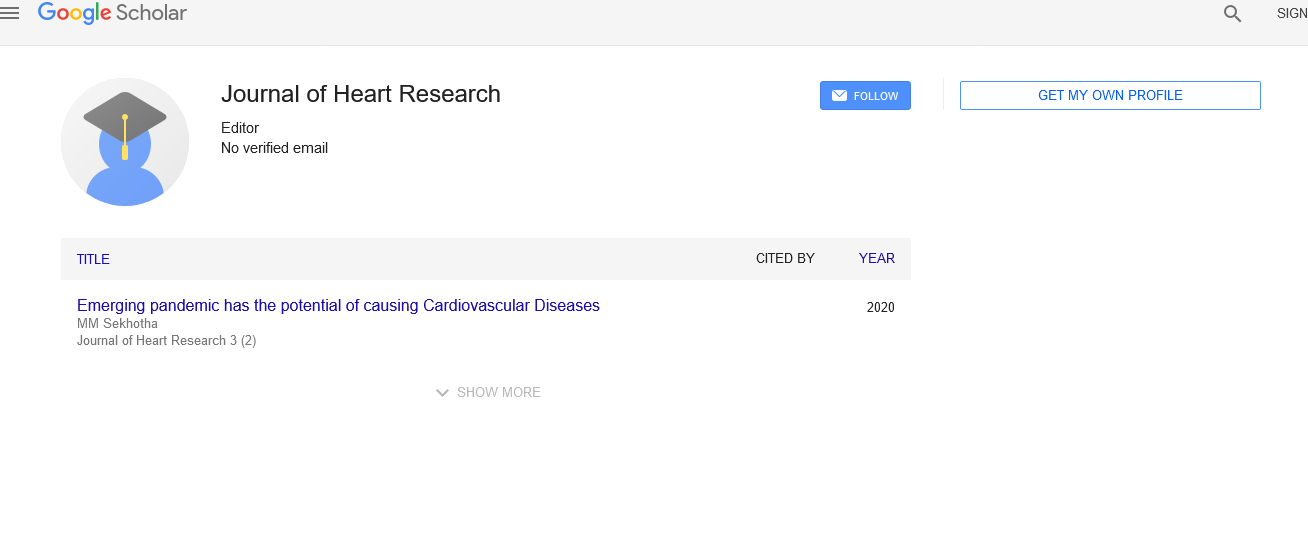An editorial of current therapeutic for atrial fibrillation
Received: 08-Aug-2022, Manuscript No. puljhr-22-5377; Editor assigned: 12-Aug-2022, Pre QC No. puljhr-22-5377 (PQ); Accepted Date: Sep 07, 2022; Reviewed: 26-Aug-2022 QC No. puljhr-22-5377 (Q); Revised: 03-Sep-2022, Manuscript No. puljhr-22-5377 (R); Published: 10-Sep-2022, DOI: 10.37532/ puljhr.2022. 5(4).01-02.
Citation: Morgan P. An editorial of current therapeutic for atrial fibrillation. Int J. Heart Res. 2022; 5(4):1-2
This open-access article is distributed under the terms of the Creative Commons Attribution Non-Commercial License (CC BY-NC) (http://creativecommons.org/licenses/by-nc/4.0/), which permits reuse, distribution and reproduction of the article, provided that the original work is properly cited and the reuse is restricted to noncommercial purposes. For commercial reuse, contact reprints@pulsus.com
Editorial
he most common cardiac arrhythmia in current clinical practice is Atrial Fibrillation (AF). In the following decades, it is anticipated that the prevalence of AF will double, increasing with age and becoming a more significant worldwide health issue. The firstline treatment for AF is frequently medical, including anticoagulants like warfarin for stroke prevention in those at risk, rate control or anti-arrhythmic medications for rhythm management [1]. In order to disturb the underlying causes and substrates for AF, cardiac tissue lesions are used in catheter ablation, a new therapy option for AF. Additionally, surgical methods for the treatment of AF have been developed, particularly for individuals who need concurrent cardiac surgery or who are unresponsive to pharmacological and catheter ablation therapies. Another recently developed method is the hybrid ablation strategy, in which the cardiothoracic surgeon and cardiologist execute both epicardial thoracoscopic ablation lesions and endocardial catheter ablation lesions in a single setting. The best method for AF ablation, as well as the energy sources and lesion sets used, are still up for debate [2]. The prevalence of AF is rising along with the population's ever-growing ageing. The upper heart chambers do not function properly in AF due to aberrant electrical signaling. On electrocardiograms, it can be distinguished by abrupt and erratic atrial depolarization as well as a distinct absence of P waves. Because the blood in the atria is stagnant, it can encourage blood clot development and raise the risk of stroke. This may result in negative symptoms, compromise functional status, and lower quality of life. Recent developments in medical technology have improved our knowledge of AF and the factors underlying its genesis. Numerous cutting-edge pharmaceutical and non-pharmacological treatments have been created [3]. The most prevalent kind of heart arrhythmia is AF. The prevalence of AF is rising along with the population's evergrowing ageing. The upper heart chambers do not function properly in AF due to aberrant electrical signalling. Rapid and erratic atrial depolarization with a distinct absence of P waves can be used to control or possibly avoid AF. Certain triggers, such as a single rapidly firing focus in the atria, are hypothesized to be the cause of AF. Following that, the heart may experience fibrillatory conduction. According to studies, the pulmonary veins or the base of the pulmonary veins is where this quick focal firing occurs most frequently. These areas contain cardiac tissue that may trigger recurrent firing or, in some situations, episodic re-entrant venous activation [4].
Rapid ectopic activity can also develop from the ligament of Marshall, coronary sinus, or the muscular sleeves of the superior vena cava. Although the precise mechanisms underpinning AF initiation due to fast firing have not yet been fully clarified, they could possibly involve improved automaticity, micro-reentry or brought about action. Pulmonary vein isolation is a possible treatment for paroxysmal AF since it appears to be caused by focused rapid firing activity in the atria. Although pulmonary vein triggers are frequently found there as well, there is a low success rate for exclusive pulmonary vein isolation in persistent AF. Thus, even though they have not yet been fully understood, other triggers may also be involved in long-lasting AF [5]. Atrial fibrillation catheter ablation offers a low incidence of postoperative problems. In recent years, there has been a dramatic decline in the rate of acute complications. This can be a result of more advanced catheter technology and knowledge. With no known association between procedural factors and complication rate, the use of various methods among centers across the world appears to be safe.
The early stages of clinical research for medications that target certain ion channels are quickly approaching. Additionally, there are a number of innovative and fascinating areas of AF research, including gene therapy, cell therapy, and the role of microRNAs in tissue remodeling. Optimized treatment approaches for those with AF are crucial given our ageing population and the rising occurrence of AF.
While technological developments have helped to clarify many elements of AF, there are still many unanswered questions. We can anticipate the development of more potent pharmacological therapy and ablation procedures in the near future as a result of ongoing research into AF [6].
References
- Bergau L, Bengel P, Sciacca V, et al. Atrial Fibrillation and Heart Failure. J Clin Med., 2022 Apr 29;11(9):2510.
- De Caterina R, Camm AJ. What is ‘valvular’atrial fibrillation? J Eur heart , 2014 Dec 14;35(47):3328-35.
- Papathanasiou KA, Giotaki SG, Vrachatis DA, et al. Molecular insights in atrial fibrillation pathogenesis and therapeutics: A narrative review. Diagnostics. 2021 Aug 31;11(9):1584.
- Caturano A, Galiero R, Pafundi PC et al. Atrial fibrillation and stroke. A review on the use of vitamin K antagonists and novel oral anticoagulants. Medicina. 2019 Sep 20;55(10):617.
- Nomani H, Mohammadpour AH, Reiner Z, et al. Statin therapy in post-operative atrial fibrillation: Focus on the anti-inflammatory effects. J Cardiovasc Dev Dis., 2021 Feb 26;8(3):24.
- Gupta A, Perera T, Ganesan A, et al. Complications of catheter ablation of atrial fibrillation: a systematic review. Circ: Arrhythmia Electrophysiol., 2013 Dec;6(6):1082-8.





